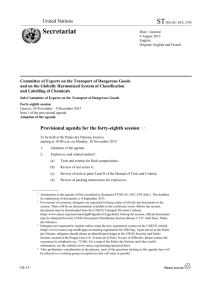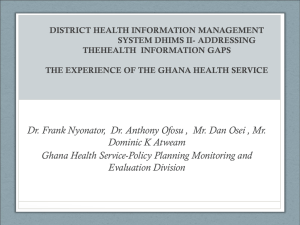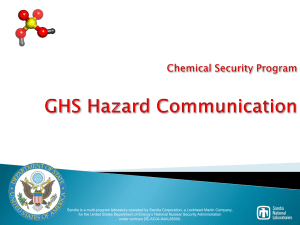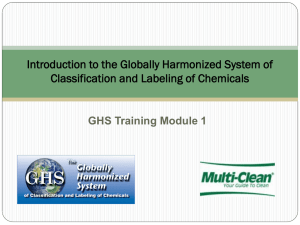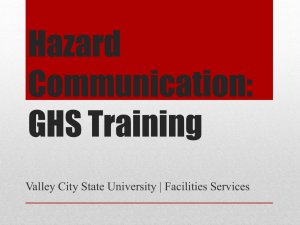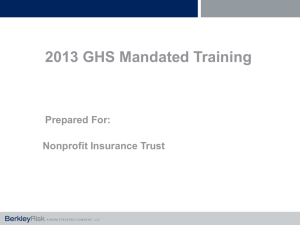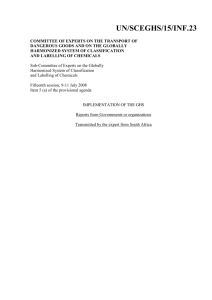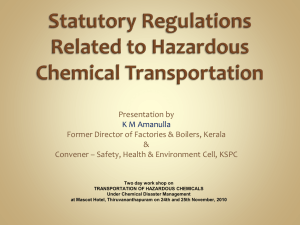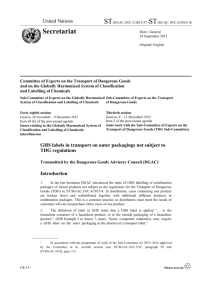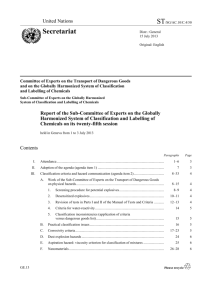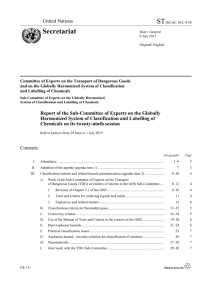1321580
advertisement
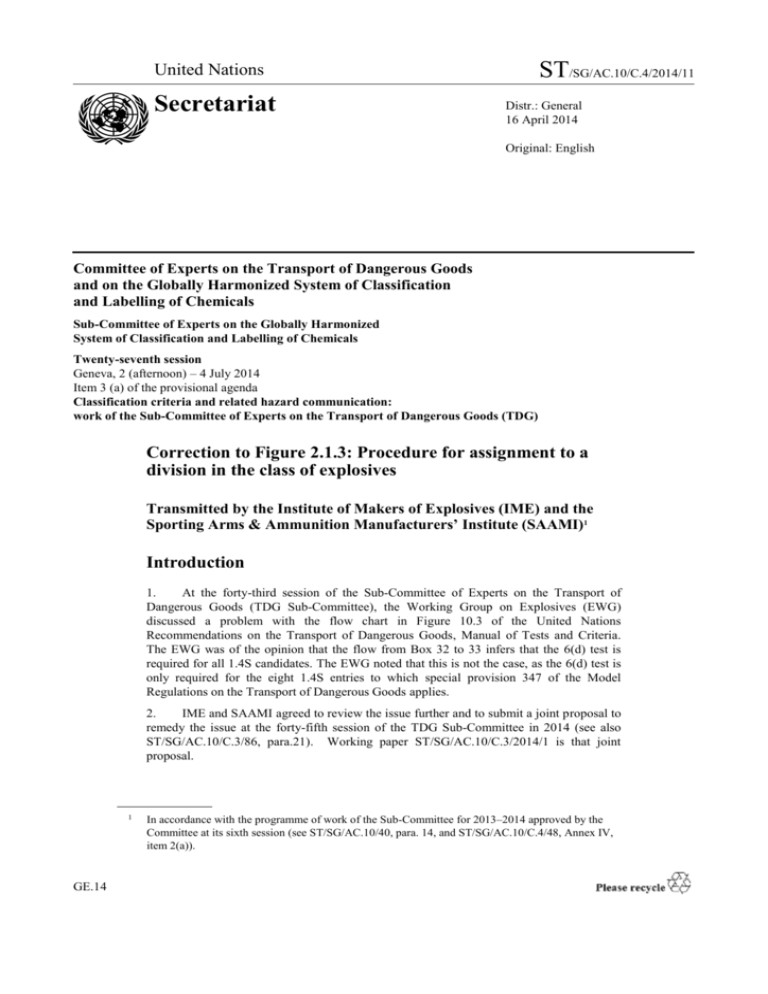
ST/SG/AC.10/C.4/2014/11 United Nations Secretariat Distr.: General 16 April 2014 Original: English Committee of Experts on the Transport of Dangerous Goods and on the Globally Harmonized System of Classification and Labelling of Chemicals Sub-Committee of Experts on the Globally Harmonized System of Classification and Labelling of Chemicals Twenty-seventh session Geneva, 2 (afternoon) – 4 July 2014 Item 3 (a) of the provisional agenda Classification criteria and related hazard communication: work of the Sub-Committee of Experts on the Transport of Dangerous Goods (TDG) Correction to Figure 2.1.3: Procedure for assignment to a division in the class of explosives Transmitted by the Institute of Makers of Explosives (IME) and the Sporting Arms & Ammunition Manufacturers’ Institute (SAAMI)1 Introduction 1. At the forty-third session of the Sub-Committee of Experts on the Transport of Dangerous Goods (TDG Sub-Committee), the Working Group on Explosives (EWG) discussed a problem with the flow chart in Figure 10.3 of the United Nations Recommendations on the Transport of Dangerous Goods, Manual of Tests and Criteria. The EWG was of the opinion that the flow from Box 32 to 33 infers that the 6(d) test is required for all 1.4S candidates. The EWG noted that this is not the case, as the 6(d) test is only required for the eight 1.4S entries to which special provision 347 of the Model Regulations on the Transport of Dangerous Goods applies. 2. IME and SAAMI agreed to review the issue further and to submit a joint proposal to remedy the issue at the forty-fifth session of the TDG Sub-Committee in 2014 (see also ST/SG/AC.10/C.3/86, para.21). Working paper ST/SG/AC.10/C.3/2014/1 is that joint proposal. 1 GE.14 In accordance with the programme of work of the Sub-Committee for 2013–2014 approved by the Committee at its sixth session (see ST/SG/AC.10/40, para. 14, and ST/SG/AC.10/C.4/48, Annex IV, item 2(a)). ST/SG/AC.10/C.4/2014/11 3. The problem and solution addressed in ST/SG/AC.10/C.3/2014/1 also affects Figure 2.1.3 of the GHS, which IME and SAAMI seek to resolve in the current proposal to avoid inconsistencies between the Manual of Tests and Criteria and the GHS. Discussion 4. The TDG Sub-Committee adopted the UN 6(d) test during its thirty-fourth session (December 2008)2. When it adopted the 6(d) test, the TDG Sub-Committee elected to apply the requirement to perform the test only to candidates for classification within the following 1.4S entries: UN0323, UN0366, UN0441, UN0445, UN0455, UN0456, UN0460, and UN0500. 5. To note this requirement, the Sub-Committee inserted a reference to Special Provision (SP) 347 in column 6 in the Dangerous Goods List against these eight entries3. SP 347 states that the classification (of the eight entries listed above) may only be assigned if, when the 6(d) test is performed, “any hazardous effects arising from functioning are confined within the package”4. 6. A discrepancy was found in Figure 10.3 of the Manual of Tests and Criteria as follows. Box 32 asks the question “Would the hazard hinder fire-fighting in the immediate vicinity?”, which is determined by the 6(c) test. A “yes” answer to box 32 flows to box 34, which is acceptance into Division 1.4 other than Compatibility Group S. A “no” answer to box 32 flows to box 33, which asks the question, “Are there hazardous effects outside the package?”. Box 33 thus implies that the 6(d) test must be applied to all items that give a “no” answer in box 32 before moving on to potential classification as Division 1.4 Compatibility Group S. Such items would be all items that are candidate for any 1.4S entry, not just those entries to which SP 347 applies. This is not correct. 7. To resolve this issue, document ST/SG/AC.10/C.3/2014/1 proposes to reference the applicability of SP 347 in the flow chart of the Manual of Tests and Criteria. However SP 347 does not exist in the GHS. Therefore, a reference to that special provision in Figure 2.1.3 of the GHS is inappropriate, and a different logical argument must be used. 8. In Figure 2.1.3 of the GHS, a box should be inserted in the “No” line between the boxes that read “Would the hazard hinder fire-fighting in the immediate vicinity?” and “Are there hazardous effects outside the package?” that limits entry into latter box to those entries to be classified as UN0323, UN0366, UN0441, UN0445, UN0455, UN0456, UN0460, and UN0500. Since the transport special provision cannot be referenced, the argument can be made by referencing the UN numbers of those products which are subject to this requirement. Use of the Manual of Tests and Criteria within the GHS 9. When IME and SAAMI submitted ST/SG/AC.10/C.3/2014/1 to the TDG SubCommittee, optimally it would have been a joint proposal for both the TDG and the GHS sub-committees. The existence of Figure 2.1.3 in the GHS was overlooked, but was discovered later, resulting in this proposal. IME and SAAMI now take note of the proposal of the Secretariat in ST/SG/AC.10/C.3/2014/61−ST/SG/AC.10/C.4/2014/8 for the modification of the Manual of Tests and Criteria to formalize links with GHS. We believe 2 3 4 2 ST/SG/AC.10/C.3/68, paras. 8 - 12 ST/SG/AC.10/C.3/68, para. 9 ST/SG/AC.10/1/Rev.18,Section 3.3.1 ST/SG/AC.10/C.4/2014/11 the Manual of Tests and Criteria flow chart replicated into the GHS as Figure 2.1.3 might better be removed and replaced with a reference to the Manual of Tests and Criteria. We recommend deleting instead of amending GHS Figure 2.1.3. Proposal Option 1 10. Delete Figure 2.1.3, and replace with a reference to the Manual Figure 10.3 of the Manual of Tests and Criteria. Option 2 11. Amend Figure 2.1.3 of the GHS by inserting a new box in the “No” line between the boxes that read, “Would the hazard hinder fire-fighting in the immediate vicinity?” and “Are there hazardous effects outside the package?”. The new box should read, “Is the explosive to be classified as UN0323, UN0366, UN0441, UN0445, UN0455, UN0456, UN0460, or UN0500?”. A “yes” answer should lead to the box that reads “Are there hazardous effects outside the package” and a “no” answer should lead to the box that reads “Is the substance/mixture or article … explosive or pyrotechnic effect?”. The proposed revision is shown in the annex to this paper. 3 ST/SG/AC.10/C.4/2014/11 Annex Revised Figure 2.1.3 ARTICLE OR SUBSTANCE PROVISIONALLY ACCEPTED INTOCLASS 1 (from figure 2.1.2) Is the article a candidate for Division 1.6? No Is the substance a candidate for Division 1.5? Yes No Package the substance TEST SERIES 6 Yes Is the result a mass explosion? TEST SERIES 7 Yes TEST SERIES 5 No Is it an extremely insensitive article? Is the major hazard that from dangerous projections? No Yes Yes Is it a very insensitive explosive substance with a mass explosion hazard? Yes No No No Is the major hazard radiant heat and/or violent burning but with no dangerous blast or projection hazard? Would the hazard hinder fire-fighting in the immediate vicinity? Yes Yes This is the proposed new box No No Is the explosive to be classified as UN0323, UN0366, UN0441, UN0445, UN0455, UN0456, UN0460, or UN0500? Yes No No Are there hazardous effects outside the package? Is the substance or article manufactured with the view of producing a practical explosive or pyrotechnic effect? Yes Yes Yes Is the product an article excluded by definition? (see Model Regulations, par. 2.1.1.1 (b)) No NOT CLASS 1 4 DIVISION 1.6 DIVISION 1.5 DIVISION 1.4 Compatibility group S DIVISION 1.4 Compatibility groups other than S DIVISION 1.3 DIVISION 1.2 DIVISION 1.1
